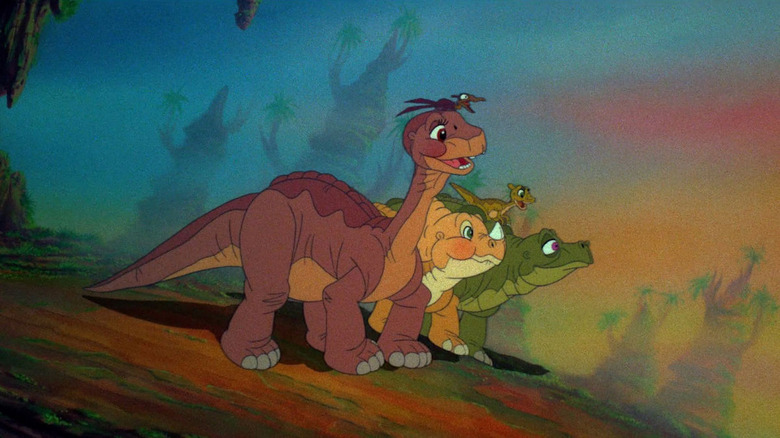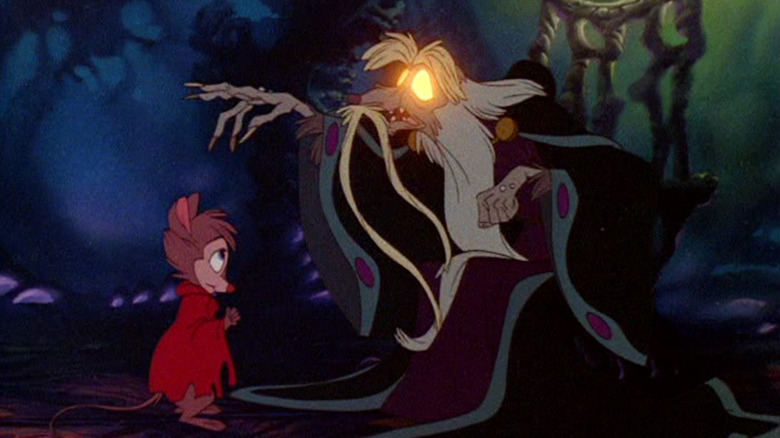How Walt Disney Animation Inadvertently Led To The Land Before Time
Although I was raised on a steady diet of Disney films, it was the work of Don Bluth that truly captured my attention as a child. Bluth also made animated features, but they were markedly different from the films of the Mouse House, serving as something of a dark reflection to the Disney movies. Disney's animation domination may now seem unshakable, but it wasn't always so. The studio had a major competitor in Bluth throughout the '80s, an era in which Disney wasn't doing great to begin with. Bluth's company was responsible for quite a few animated classics, chief among them: "The Secret of NIMH" (1982), "An American Tale" (1986), "The Land Before Time" (1988), and "All Dogs Go to Heaven" (1989).
Regarded by many as Bluth's finest film, "The Land Before Time" was much more than a cartoon about dinosaurs. Produced by Steven Spielberg and George Lucas, the movie is equal parts delightful, terrifying, and gut-wrenching. Grief and loss are difficult concepts for kids to grasp, but the movie doesn't shy away from any of it. I not only obsessively watched "The Land Before Time" as a kid, but I also viewed "The Secret of NIMH" and "All Dogs Go to Heaven" more times than I'll ever be able to count. Bluth's films taught me about love and family, but also about pain and sorrow, which are equally important lessons to learn. Side note: "The Secret of NIMH" caused me to greatly overestimate the intelligence of rats for a large percentage of my life. Look, I know rats are pretty damn smart, but they can't really steal electricity ... right?
These films were darker, scarier, and more intense than Disney's output, and while I loved the Mouse House too, their movies didn't resonate with me in the same way. Bluth's films broke my heart, and yet, I returned to them again and again. These movies refused to talk down to their audience, despite the fact that it was mainly comprised of children. This is probably why his work resonates so much with adults as well. Bluth may have been a thorn in Disney's side, but interestingly, it was the House of Mouse that gave way to these animated classics in the first place. So, how did Walt Disney Animation actually lead to "The Land Before Time?"
Don Bluth Used To Work For Disney
Don Bluth actually got his start as an animator with Walt Disney Productions in the '50s, working on "Sleeping Beauty." He quickly made a name for himself within the company, but soon left in order to do some missionary work at the behest of his bishop — Bluth is a devout Mormon. When Bluth returned to Disney in 1971, it was quite different. Walt Disney had died in 1966 and Bluth felt things had changed for the worse in the years since. He eventually became disillusioned with the studio and left to form his own in 1979. Several other animators followed him out the door, including John Pomeroy and Gary Goldman, who were also founding members of Don Bluth Productions, which went through several other iterations. Bluth explained to LDS Living:
"Some people used to ask, 'Well, why did you leave Disney?' because that seems like a silly thing to do. I left basically because Walt left. And if Walt wasn't there, the vision wasn't there. It became a mechanical process. . . . So why not make it better, when really what was driving it was bringing the cost down? . . . I mean, Michelangelo took a while to paint the Sistine Chapel. If you told him, 'You have a month,' what would you get?"
There was more to it than that though. Bluth also disagreed with Disney from a storytelling perspective. According to Bluth, "a story is as strong as your villain factor." He felt that the earlier Disney films were exceptional in this area, but that the company was moving away from this more and more, in an effort to keep viewers from getting upset. He didn't like what he saw as a turn towards something more comedic, and instead, opted to tell his own stories.
Don Bluth's Legacy
The exit of so many employees left Disney Animation in a difficult spot that the company would take significant time to rebound from. While Bluth's first feature, "The Secret of NIMH," was a critical success, it was a commercial flop. However, Spielberg was a fan and his company produced "An American Tail," which was far more successful. It became the highest-grossing animated feature not made by Disney and even beat out the "The Great Mouse Detective" at the 1986 box office. "The Land Before Time" found similar success in 1988 and had a larger opening weekend than Disney's "Oliver & Company." Though the latter would eventually make more money domestically, the former took in more worldwide.
It seemed like Bluth was going to actually unseat Disney as reigning champs of animation, but everything changed with the 1989 release of "The Little Mermaid", which clobbered Bluth's own "All Dogs Go to Heaven" at the box office. Like most of his movies, "All Dogs Go to Heaven" did find more success after the fact on home video. Honestly, of the two, "All Dogs Go to Heaven" is the one that has affected me more, both as a child and as an adult.
Of all Bluth's films, "The Land Before Time" is the one that has continued to live on. The film spawned 13 sequels (the most recent released in 2016) and a TV show. Bluth had no involvement in these projects and while I haven't seen them, it seems safe to say they lack the artistic merit of the original. It's been a few years since I've watched "The Land Before Time" — though not as many as you might think — and, like Bluth's best works, the film has continued to stick with me.
Bluth not only served as major competition for Disney for a time, but his legacy is a string of incredible films. Even the movies that have largely faded into obscurity like "The Secret of NIMH" are now considered classics. Goliath may have beaten David in this scenario, but it seems impossible to argue that Bluth's success forced Disney to up their game, leading to the Disney Renaissance of the late '80s and '90s.


